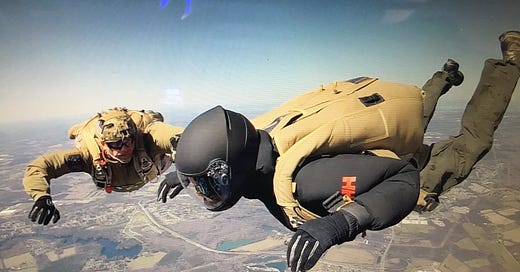I loved jumping out of airplanes during my military service. Whether they were “perfectly good” or not wasn’t up to me to determine. The door opened; the green light popped; I jumped out on the jumpmaster’s command. Simple.
Trained in Miliary Free Fall—think tactical skydiving—like most things in my life which I enjoy, I wasn’t the best at it and worked hard at being mediocre. With just more than 200 jumps to my credit—not many by any stretch of the imagination—I was good enough to have competence and confidence in my abilities. I’ve also nearly been killed while doing it. Twice.
The first time was in 2003 in Yuma, Arizona, but that’s for another project, so I won’t go into the details in this post. That accident changed my life.
The second time, and the second-to-last jump of my career, was in 2021 on a beautiful October day over Suffolk, Virginia.
Air operations are risky and the unit I was assigned to runs a fantastic jump program. Their approach to training was one of systematic safety coupled with aggressive jump profiles. Equipment was first rate, support personnel were always on time, air support never fell through, and the only thing that stopped training was weather.
On a picture-perfect afternoon, I ascend to 12,500 feet along with eight other jumpers and we ride in the rear of the Twin Otter jump airplane with mellow adrenaline coursing through our veins. None of us take what we were about to do for granted, even though we’ve done this many times, this being the second lift of four we are scheduled.
Ascending in large, lazy circles, I rehearse my emergency procedures for deploying my reserve parachute, one of the first things a jumper is trained to do, and repeat them to myself again, talking through each of the steps. I have it wrote, and we’d covered it as part of our pre-jump brief to start the morning, but I always go over it in the airplane for muscle memory. You never want to use it, and if you do have to go through the actions, you must do it perfectly. You’d only get one chance.
Periodically, I check my altimeter for our altitude and look at the other three members of my group, each alone in our thoughts.
The plane stops climbing and settles into a slower forward airspeed. The jumpmaster opens the rear ramp, flooding the interior with blustery, cool air which evicts the smell of fuel and hydraulic fluid. He gives the hand signal to stand up and we encourage each other with a fist bump. I look out into a cobalt blue sky, the trees in vibrant hues of autumn stretched out beneath us. I take a deep breath and slowly exhale to calm my mind when the red-light snaps on and the group of four ahead of us moves to the ramp’s edge.
The jump light switches from red to green and the jumpmaster points “go.” The entire back of the plane sinks and rises in a bobbing motion when the first four jumpers exit. The rest of us move to the end of the ramp and within five seconds are ourselves in free fall, at first weightless, then heavy as we gain velocity and punch through the sky. Exciting doesn’t do it justice.
Falling in the sky is surreal. You’re screaming through the air, an earth-bound missile traveling 120 mph and simultaneously, people around you are traveling relative to your speed and things take on their own pace in an odd, satisfying way. You are in tune with your surroundings in a pocket of chaos.
At 10,000 feet, my compatriots and I link up in the sky and form a “Four-way” whereby we each have ahold of each other’s arms in a square. We fall like this for 40 seconds, grinning and marveling at the experience, before signaling to break away from the formation at 5,500 feet and find a piece of unoccupied sky in which to pull our parachutes.
I turn away and track out and over the drop zone, checking beneath me for another jumper, and then clear my airspace with vigorous waves overhead. I check my altimeter and pull my main parachute at 4,500 feet and begin counting as the parachute deploys off my back.
One thousand. The pilot parachute pulls the main canopy out of the tray, I feel it dragging in the sky.
Two thousand. By now the deployment bag is free of the canopy. I should be slowing, but I’m not.
Keep reading with a 7-day free trial
Subscribe to The Logbook to keep reading this post and get 7 days of free access to the full post archives.




